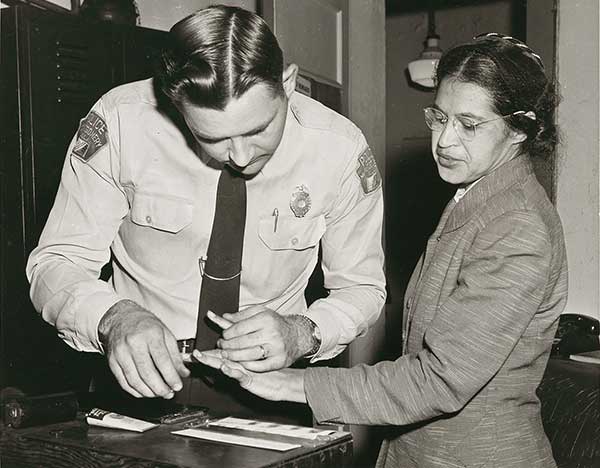Rosa Parks (1913–2005)

I
On December 1, 1955, Rosa Parks’s courageous act of civil disobedience helped to launch the modern civil rights movement. Parks was riding a public bus home from her job as a seamstress when she refused the bus driver’s demand that she surrender her seat to a white male passenger. When Parks was arrested and convicted of violating local segregation laws, Montgomery’s African American community, led by the Women’s Political Council, launched a massive one-day boycott of the city’s bus system. In the wake of the day’s success, the community pledged to continue the boycott, forming the Montgomery Improvement Association to manage it and electing Martin Luther King Jr., a young local minister, as the organization’s president. Under King’s leadership, the boycott lasted 382 days, attracting considerable national attention. It ended only after the U.S. Supreme Court ruled in the case of Browder v. Gayle that bus segregation violated the Fourteenth Amendment, applying the precedent set by Brown v. Board of Education in 1954.
As the boycott stretched on into the early months of 1956, white city leaders tried to find ways to intimidate the black community into giving up. On February 22, 1956, eighty-nine African American residents of Montgomery—including Rosa Parks, Martin Luther King Jr., Jo Anne Robinson of the Wom- en’s Political Council, and many other prominent figures—were indicted under a 1921 law “prohibiting conspiracies that interfered with lawful business.” Before they could be arrested, those under indictment peacefully turned themselves in and were released on bond. This photograph, taken by Associated Press photographer Gene Herrick, shows Parks being fingerprinted at the police station on February 22. In the end, only King was tried and convicted for the February 22 charge. He was ordered to pay $500 or to serve 386 days in jail. After his appeal was rejected, he paid the fine in December 1957.
The boycott took a toll on Parks’s life in Montgomery; both she and her husband lost their jobs and had difficulty finding work. In 1957 they moved to Detroit, Michigan, where Parks served on the staff of U.S. Representative John Conyers. In 1977 she founded an institute to teach teenagers to be civil rights activists. Hailed as the “Mother of the Civil Rights Movement,” she went on to receive many honors and awards, including a Presidential Medal of Freedom and a Congressional Gold Medal.
Learning to Look:
- Describe what you see in this portrait. What do you think is happening here?
- Write a caption (twenty words maximum) that describes what is going on in the photograph. How do the different elements in the portrait combine to tell the story? Consider the setting, clothing, pose, facial expressions, and objects.
- If you saw this photograph in a newspaper, how would it make you feel? What questions would you have about it?
Suggested Activity:
This photograph of Rosa Parks was taken by Gene Herrick, an Associated Press photographer, and distributed over the AP wire service to newspapers around the country. Imagine that you are a newspaper editor in 1956 who supports the boycott and the growing civil rights movement. Write an editorial in support of the movement’s tactics (and against segregation laws), using the photograph as evidence to support your points. As you write, consider the following questions:
- Who is your audience? Are you writing for a national newspaper or a local one? If local, where are you located? Is your readership primarily white, primarily African American, or both?
- What are your main arguments against segregation? Come up with at least two.
- What are your main arguments in support of the boycott? Why do you think it is a good idea?
- How does the photograph provide evidence in support of your argument?
- What sort of emotions do you think the photograph will elicit in your readers? How can you use those emotions to make your readers agree with your arguments?